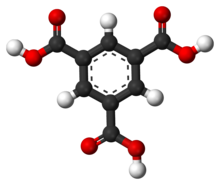Trimesic acid

| |

| |
| Names | |
|---|---|
| Preferred IUPAC name
Benzene-1,3,5-tricarboxylic acid | |
| Identifiers | |
3D model (JSmol)
|
|
| 2053080 | |
| ChEBI | |
| ChEMBL | |
| ChemSpider | |
| DrugBank | |
| ECHA InfoCard | 100.008.253 |
| EC Number |
|
| 51147 | |
PubChem CID
|
|
| UNII | |
CompTox Dashboard (EPA)
|
|
| |
| |
| Properties | |
| C9H6O6 | |
| Molar mass | 210.14034 |
| Acidity (pKa) | 3.12, 3.89, 4.70[1] |
| Hazards[2] | |
| Safety data sheet (SDS) | Oxford MSDS |
| GHS labelling: | |

| |
Signal word
|
Warning |
| H315, H319, H335 | |
| P261, P264, P271, P280, P302+P352, P304+P340, P305+P351+P338, P312, P321, P332+P313, P337+P313, P362, P403+P233, P405, P501 | |
Except where otherwise noted, data are given for materials in their standard state (at 25 °C [77 °F], 100 kPa). | |
| Infobox references | |
Trimesic acid, also known as benzene-1,3,5-tricarboxylic acid, is an organic compound with the formula C6H3(CO2H)3. It is one of three isomers of benzenetricarboxylic acid.[3] A colorless solid, trimesic acid has some commercial value as a precursor to some plasticizers.[4]
Trimesic acid can be combined with para-hydroxypyridine to make a water-based gel, stable up to 95 °C.[5]
Trimesic acid crystallizes from water in a hydrogen-bonded hydrated network with wide unidimensional empty channels.[6]
See also[]
- Trimellitic acid (1,2,4-benzenetricarboxylic acid)
- Hemimellitic acid (1,2,3-benzenetricarboxylic acid)
References[]
- ^ Brown, H.C.; McDaniel, D.H.; Häfliger, O. (1955). "Chapter 14—Dissociation Constants". In Braude, E.A.; Nachod, F.C. (eds.). Determination of Organic Structures by Physical Methods. New York: Academic Press. doi:10.1016/B978-1-4832-3166-2.50018-4.
- ^ "1,3,5-Benzenetricarboxylic acid". pubchem.ncbi.nlm.nih.gov.
- ^ Marković, Zoran; Badjuk, Dalibor; Gutman, Ivan (2004). "Geometry and Conformations of Benzenecarboxylic Acids". J. Serb. Chem. Soc. 69 (11): 877–882. doi:10.2298/JSC0411877M.
- ^ Röhrscheid, Freimund (2000). "Carboxylic Acids, Aromatic". Ullmann's Encyclopedia of Industrial Chemistry. Weinheim: Wiley-VCH. doi:10.1002/14356007.a05_249.
- ^ Tang, Li Ming; Wang, Yu Jiang (2009). "Highly Stable Supramolecular Hydrogels Formed from 1,3,5-Benzenetricarboxylic Acid and Hydroxyl Pyridines". Chinese Chemical Letters. 20 (10): 1259–1262. doi:10.1016/j.cclet.2009.04.030.
- ^ Herbstein, Frank H. (1987). "Structural Parsimony and Structural Variety Among Inclusion Complexes (with Particular Reference to the Inclusion Compounds of Trimesic acid, N-(p-tolyl)-tetrachlorophthalimide, and the Heilbron "Complexes")". Top. Curr. Chem. Topics in Current Chemistry. 140. pp. 107–139. doi:10.1007/bfb0003838. ISBN 3-540-17307-2.
Categories:
- Benzoic acids
- Tricarboxylic acids
- Organic compound stubs